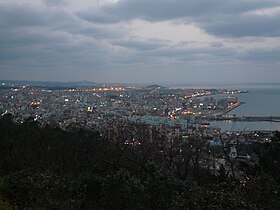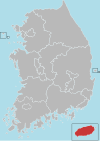Jeju City
This article needs additional citations for verification. (March 2010) |
Jeju City
제주시 濟州市 | |
|---|---|
| Korean transcription(s) | |
| • Hangul | 제주시 |
| • Hanja | 濟州市 |
| • Revised Romanization | Jeju-si |
| • McCune-Reischauer | Cheju-si |
 Overview of Jeju City | |
 | |
| Land | |
| Region | Jeju |
| Administrative divisions | 19 dong, 4 eup, 3 myeon |
| Area | |
| • Total | 977.8 km2 (377.5 sq mi) |
| Population (2007) | |
| • Total | 408,364 |
| • Density | 1,014.8/km2 (2,628/sq mi) |
| • Dialect | Jeju |
Jeju (Jeju-si) is the capital of Jeju province in Südkorea and the largest city on the island of Jeju. Its geographical location is 33°30′N 126°31′E / 33.500°N 126.517°E. The city is served by Jeju International Airport (IATA code CJU).
Located in a southern island where the weather is mild even in winter, the city is a famous resort with public casino facilities. Jeju welcomes over 4 million visitors from mainland Korea, Japan, and China every year.
Geography
In its former boundaries, Jeju City was 19.3 kilometers from east to west, and 10.2 kilometers from north to south. To the north, it looks across the Korea Strait at the southern coast of South Jeolla Province. To the south, it meets Seogwipo City at the top of Hallasan, the island's sole mountain.
Climate
| Climate data for Jeju City, South Korea (1971-2000) | |||||||||||||
|---|---|---|---|---|---|---|---|---|---|---|---|---|---|
| Month | Jan | Feb | Mar | Apr | May | Jun | Jul | Aug | Sep | Oct | Nov | Dec | Year |
| Mean daily maximum °C (°F) | 8.3 (46.9) |
8.9 (48.0) |
12.2 (54.0) |
17.3 (63.1) |
21.3 (70.3) |
24.7 (76.5) |
28.8 (83.8) |
29.5 (85.1) |
25.6 (78.1) |
21.1 (70.0) |
15.8 (60.4) |
10.9 (51.6) |
18.7 (65.7) |
| Daily mean °C (°F) | 5.6 (42.1) |
6.0 (42.8) |
8.9 (48.0) |
13.6 (56.5) |
17.5 (63.5) |
21.2 (70.2) |
25.7 (78.3) |
26.5 (79.7) |
22.7 (72.9) |
17.8 (64.0) |
12.6 (54.7) |
8.0 (46.4) |
15.5 (59.9) |
| Mean daily minimum °C (°F) | 3.0 (37.4) |
3.1 (37.6) |
5.6 (42.1) |
9.8 (49.6) |
13.9 (57.0) |
18.2 (64.8) |
23.0 (73.4) |
23.8 (74.8) |
19.7 (67.5) |
14.5 (58.1) |
9.4 (48.9) |
5.0 (41.0) |
12.4 (54.3) |
| Average precipitation mm (inches) | 63.0 (2.48) |
66.9 (2.63) |
83.5 (3.29) |
92.1 (3.63) |
88.2 (3.47) |
189.8 (7.47) |
232.3 (9.15) |
258.0 (10.16) |
188.2 (7.41) |
78.9 (3.11) |
71.2 (2.80) |
44.8 (1.76) |
1,457 (57.36) |
| Average relative humidity (%) | 69.2 | 69.4 | 69.3 | 71.2 | 73.7 | 80.1 | 81.6 | 79.8 | 75.8 | 70.7 | 69.3 | 68.9 | 73.3 |
| Mean monthly sunshine hours | 73.5 | 99.6 | 159.7 | 195.1 | 217.9 | 174.6 | 203.4 | 205.2 | 168.8 | 180.0 | 129.2 | 91.9 | 1,898.9 |
| Source: [1] | |||||||||||||
History
The area of the city has played a central role in Jeju since before recorded history. The Samseonghyeol, holes from which the three ancestors of the Jeju people are said to have come, are located in downtown Jeju City.
The city has grown quite rapidly since the 1970s. Shin Jeju (신제주), or "new Jeju", was created some decades ago, up the hill from the airport and houses many government buildings. The thatched roof buildings that were common throughout the city until the 1970s are gradually disappearing.
The city was separated from Bukjeju County in 1955. However, in 2005 Jeju Province voters approved a proposal to merge the city with Bukjeju County, also merging Seogwipo with Namjeju County to create two large cities directly administered by the province. That change was put into effect in July 2006.
Administrative divisions
Jeju is divided into 19 neighbourhoods (dong), 4 towns (eup), and 3 townships (myeon):[1] {{Top}} may refer to:
- {{Collapse top}}
- {{Archive top}}
- {{Hidden archive top}}
- {{Afd top}}
- {{Discussion top}}
- {{Tfd top}}
- {{Top icon}}
- {{Top text}}
- {{Cfd top}}
- {{Rfd top}}
- {{Skip to top}}
{{Template disambiguation}} should never be transcluded in the main namespace.
- Aeweol-eup (애월읍)
- Gujwa-eup (구좌읍)
- Hanrim-eup (한림읍)
- Jocheon-eup (조천읍)
- Chuja-myeon (추자면)
- Hangyeong-myeon (한경면)
- Udo-myeon (우도면)
- Ara-dong (아라동)
- Bonggae-dong (봉개동)
- Dodu-dong (도두동)
- Geonip-dong (건입동)
- Hwabuk-dong (화북동)
- Ido-1-dong (이도1동)
| class="col-break " |
- Ido-2-dong (이도2동)
- Iho-dong (이호동)
- Ildo-1-dong (일도1동)
- Ildo-2-dong (일도2동)
- Nohyeong-dong (노형동)
- Oedo-dong (외도동)
- Ora-dong (오라동)
- Samdo-1-dong (삼도1동)
- Samdo-2-dong (삼도2동)
- Samyang-dong (삼양동)
- Yeon-dong (연동)
- Yongdam-1-dong (용담1동)
- Yongdam-2-dong (용담2동)
Transport
Jeju City is the principal transportation center for Jeju Province. It is home to the island's sole airport, Jeju International Airport. In addition, its port is the largest on the island, serving the great majority of passenger and cargo vessels that visit the island. It also stands at the center of the island's road network. To travel throughout the city and island, various buses are available and affordably priced, typically running approximately 1,000 won (0.90 Cents USD)for one ride. A bus ride from Jeju City to Seogwipo (the second largest city on the island) is typically an hour.
Economy
Jeju Air has its headquarters in Jeju City. The city also sells lots of oranges for which Jeju is famous. Jeju City is surrounded by orange and mandarin farms. [2][3]
Tourism
Due to its central position in transportation, Jeju City gets the lion's share of tourist traffic to the island. Many tourists arrive at the city through the port terminal or airport, stay in the tourist hotels of the Sinjeju neighborhood, and stay within the city to visit various Jeju tourist attractions. These include Dragon's Head Rock along the coast, the Samseonghyeol holes in the downtown area, Hallasan National Park in the interior, the country's tallest mountain Halla-san, and world's largest botanical garden Bunjae Artpia.
Sister cities
 Adelaide, Australien
Adelaide, Australien Brisbane, Australien
Brisbane, Australien Wakayama, Wakayama Prefecture, Japan
Wakayama, Wakayama Prefecture, Japan Beppu, Ōita Prefecture, Japan
Beppu, Ōita Prefecture, Japan Rouen, Frankreich
Rouen, Frankreich Shanghai, People's Republic of China
Shanghai, People's Republic of China Guilin, Guangxi Autonomous Region, People's Republic of China
Guilin, Guangxi Autonomous Region, People's Republic of China Yangzhou, Jiangsu Province, People's Republic of China
Yangzhou, Jiangsu Province, People's Republic of China Kunshan, Suzhou, Jiangsu Province, People's Republic of China
Kunshan, Suzhou, Jiangsu Province, People's Republic of China Santa Rosa, California, United States of America
Santa Rosa, California, United States of America
Jeju has a "Memorandum of Understanding" with Ulm, Germany.[4]
See also
References
- ^ "제주시소개 - 지리정보" (in Korean). Jeju City homepage. Retrieved 2008-08-15.
{{cite web}}: Text "면적" ignored (help) - ^ "Contact Us." Jeju Air. Retrieved on March 5, 2010.
- ^ "print_jeju.html." Jeju Air. Retrieved on March 5, 2010.
- ^ "Ulm - International Contacts" (in German). City of Ulm. Retrieved 2011-02-22.


